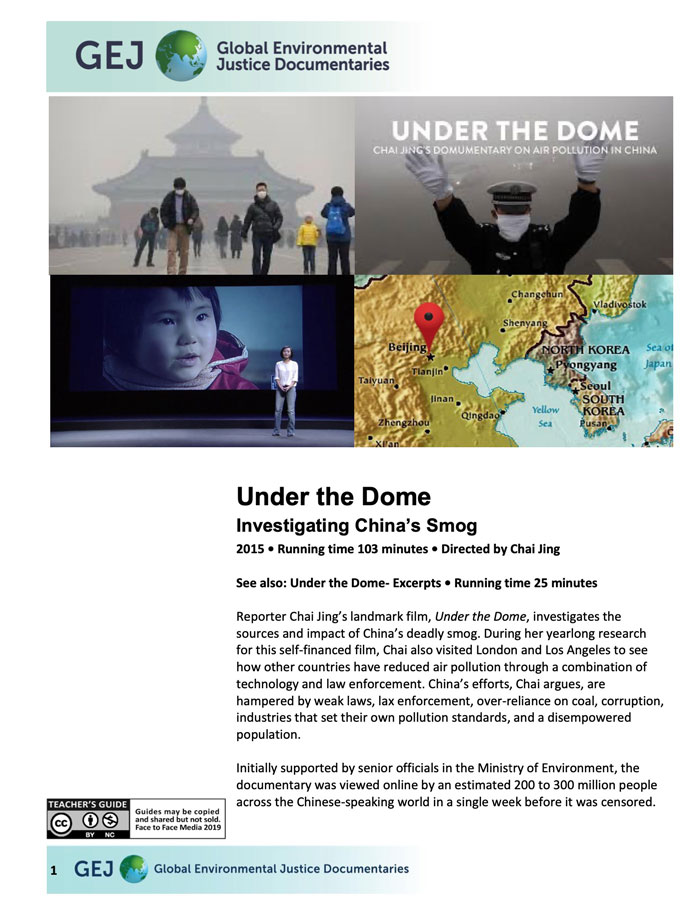Curator
 — Yifei Li, Assistant Professor of Environmental Studies, NYU Shanghai; Global Network Assistant Professor, NYU
— Yifei Li, Assistant Professor of Environmental Studies, NYU Shanghai; Global Network Assistant Professor, NYU
Under the Dome
This daring documentary by Chai JIng a former reporter for China Central Television investigates the deadly fog that hung over China's cities. Initially supported by officials it was quickly banned when it was releaseed, but not before 200 million viewers had seen it.

An excerpt from an interview with Chai Jing by People's Daily
Background
Chai Jing is a former reporter for China Central Television (CCTV) Her film Under the Dome, directed and financed by Chai Jing was the product of her year- long investigation into the sources of smog in China. The film was motivated, Jing has said, by the discovery that her child had a tumor at the time of birth. The film was originally released online by Peoples' Daily, an official newspaper of the Communist Party and it caused a sensation. An estimated 200 million viewers watched it online before it was censored the following week. During that short widow in March 2015, People's Daily published an interview with Chai which was also taken down but not before it was translated into English by the California based China Digital Times.
People’s Daily Reporter (PDR): When you left China Central Television why did you choose smog as a topic to focus on?
Chai Jing (CJ): This was not a planned project. At the time my child was sick, and I wanted to spend some time with her and take care of her after I quit my job. I declined all job offers. While I was taking care of her, my feelings about the smog became more and more intense; my whole life was affected by it. Also, all of society was becoming more concerned about air pollution. Professional training and the instinct of a mother made me think it was necessary to answer these questions: What is smog? Where did it come from? What should we do about it? So I did this investigation.
PDR: How did you think of making this public?
CJ: At first I didn’t. I just searched for sources on my own and asked experts, hoping to solve some puzzles. I retrieved satellite pictures of North China over the past ten years. I could see that air pollution had existed for a long time. I live in Beijing, so why wasn’t I aware of that? ...
As a member of the media, I feel deeply responsible, because I was in Beijing yet I felt nothing. I had done a number of reports on pollution and I always felt as if pollution only exists when you see a chimney or a factory or a mine. So I was living in a big city and was feeling nothing.
Everyone learns out of ignorance. Now that I am aware of it, as a member of the media, I have the responsibility to explain it to everyone. Not to sensationalize, not to dodge, just to explain as clearly as possible. Because if people underestimate the difficulty and complexity of controlling pollution, they may lose patience and feel hopeless. If people treat the problem too lightly and leave it the way it is, that is even more unacceptable.
So if we explain the situation as clearly as possible, publicly, perhaps many people will change as I did, and contribute something to improve air quality... China has promised to reach its peak carbon emissions around 2030. Carbon emissions and smog have the same origin, and reducing one will have coordinated effects. Now that the peak is set, we must aim in the direction of a green, low-carbon, circular economy, and not continue down the road of GDP worship. A nationwide management system, energy strategy, and industrial structure will lead to change, which will hugely impact the life of the common people
The full interview can be found here: https://chinadigitaltimes.net/2015/03/translation-peoples-daily-interview-chai-jing/
" Under the DomeI has ignited a national debate across China, with millions stopping to pay attention to an issue that has been lingering in the air for years."
--Celia Hatton, BBC News
"Under the Dome was an eye-opener for many, particularly given the unprecedented access the journalist gained on the ground. The documentary shows factories breaking regulations and authoritative figures who speak frankly, revealing the scathing truth that rules are simply ignored and that punishment stunts growth and costs people jobs.: will this film be China’s environmental awakening?" -- Yuan Ren, The Guardian
Citation
Main credits
Chai, Jing (filmmaker)
Distributor credits
Chai Jing
Full credits are found at the end of the film.
Docuseek subjects
Citizenship, Social Movements and Activism
Asian Studies
China
Biology
Communication and Media Studies
Film and Video Studies
Journalism and the Press
Environmental Law
Human Rights Law
Energy
Pollution
Toxic Chemicals
Philosophy, Critical Thinking and Ethics
Business Ethics
Global / International Studies
Government Policy
Health, Healthcare, Medicine and Nursing
Environmental Health
Maternal and Child Health
Public Health
Fossil Fuels
United Kingdom
North American Studies
Occupational Health and Safety
Women's Studies
Distributor subjects
Asian Studies
Biology
China
Communications and Media Studies
Development
Environmental Education
Environmental Health
Environmental Justice
Ethics
Global Issues
Government
Health and Health Care
Jouranlism
North American Studies
Occupational Health and Safety
Pollution
Public Health
Rivers
Solutions
Toxic Chemicals
Toxic Waste
UK
United States
Youth and Family
Keywords
Welcome to Docuseek2!
Docuseek2 is a streaming platform of the best documentary and social issue films available for the higher education community.
Anyone may search for titles and find detailed information about the titles. To preview films or license them for streaming, you must register and login.
Currently, we support online registration for anyone affiliated with a higher education institution. Please inquire if you are with a K-12 district or school or with a public library.
Click the Close button to get started!


